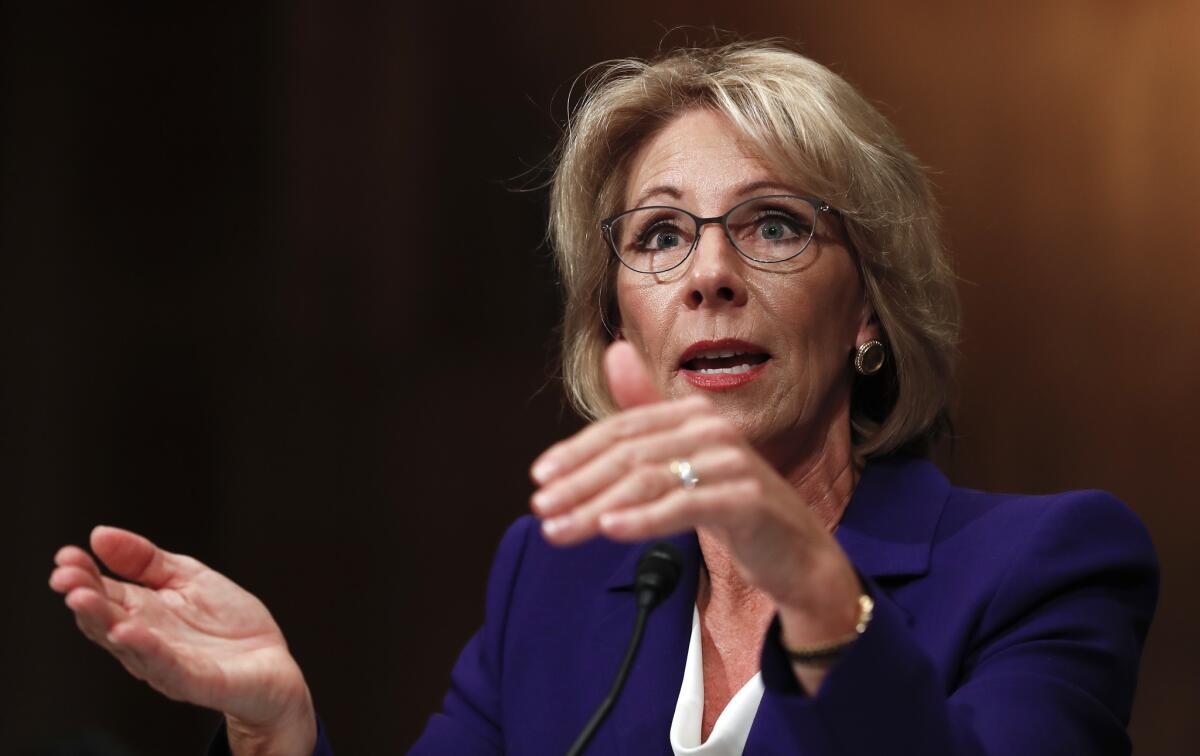Federal student loan forgiveness program rejects almost everyone, again

WASHINGTON â Americans who spend at least a decade in public service jobs and faithfully make their federal student loan payments shouldnât owe any more. Thatâs the idea behind a student debt forgiveness program the Education Department launched under President George W. Bush.
The first batch of teachers, nurses, military personnel and other public servants got to start applying for forgiveness two years ago, and the department â led by President Trump appointee Betsy DeVos â rejected nearly 99% of them. The department said more than half of them were denied for not having 10 yearsâ worth of qualifying payments. Applicants said that loan servicers had misled them into enrolling in the wrong loan repayment plans, and a consumer protection agency accused the company overseeing the program of botching paperwork.
Congress stepped in and ordered a program expansion in 2018 to offer the applicants another chance to clear their federal student loans through a new program with simpler requirements. But a year later, a new watchdog report has found, the Education Department has rejected 99% of those applicants too.
The Government Accountability Office report released Thursday found that of the more than 54,000 applications to the new program â named Temporary Expanded Public Service Loan Forgiveness â processed through May, only 661 were accepted. Investigators said that of the $700 million Congress gave the department to spend on the new program across two years, it had used less than $27 million.
The biggest reason borrowers were rejected under the new program, the report found, was that they hadnât separately applied to the original program â a requirement that Congress didnât order and that applicants found confusing. Thereâs no formal appeals process, the report said, and key parts of the Education Department website lack information about the new program.
College admissions scandal: USC officials discussed how much parents would donate when consider admissions of children, records show
Congress allocated money to fix the program as part of a 2018 federal spending bill based on legislation introduced by Sens. Tim Kaine (D-Va.) and Sheldon Whitehouse (D-R.I.).
âWe created a fix to this program and provided the Trump administration with hundreds of millions of dollars to give borrowers the loan relief they were promised, but instead theyâve left public servants in the lurch again,â Kaine said in a statement. âItâs outrageous that they still canât get this right. The Trump administrationâs failure to implement this program is placing a huge financial burden on countless families.â
The Education Department failed to offer rejected applicants complete information on how to appeal, the report said. The rejection letter contains a phone number for the relevant loan servicer. The servicer could choose whether to take a second look at the application and could consult the Education Department â but the letter does not say so, the report said. Other avenues to an appeal are to complain to the Federal Student Aid ombudsman group or file a complaint through the Federal Student Aid websiteâs feedback tool, but the Education Department intentionally does not tell applicants that, the report says.
The absence of information goes further, the report found. It said that the Education Departmentâs âkey online resources,â such as its primary web pages and help tools, lack any information about the new program, and that the information is also missing from almost all loan servicersâ websites.
âIâve fought hard to help public servants who for years have been paying into this program in good faith to get the relief they were promised,â Whitehouse said in an email. âThis report underscores that the Department of Education needs to do better in implementing the funding Congress has secured. And it highlights that Congress needs to do more to do right by these borrowers.â
The Education Department did not respond to requests for comment.
Robert Cameronâs new job is to protect student loan borrowers from poor industry practices. His previous employer has been cited for poor industry practices.
The Government Accountability Office suggested ways to simplify the process. It recommended combining the applications for the original program and the new program. It also suggested that the Education Department clarify the options borrowers have to appeal decisions, that loan servicers be required to provide online information about the new program and that information about the new program be added to online help tools that are geared toward the original program.
âWhile the loan forgiveness opportunity through [the new program] is only available until the $700 million in funding has been spent, a relatively small amount of total funding has been spent so far,â the report said. âIt is possible that the program could continue for years, supporting the case for investing in improvements to the process now.â
Times staff writer Suhauna Hussain contributed to this report.
More to Read
Inside the business of entertainment
The Wide Shot brings you news, analysis and insights on everything from streaming wars to production â and what it all means for the future.
You may occasionally receive promotional content from the Los Angeles Times.












